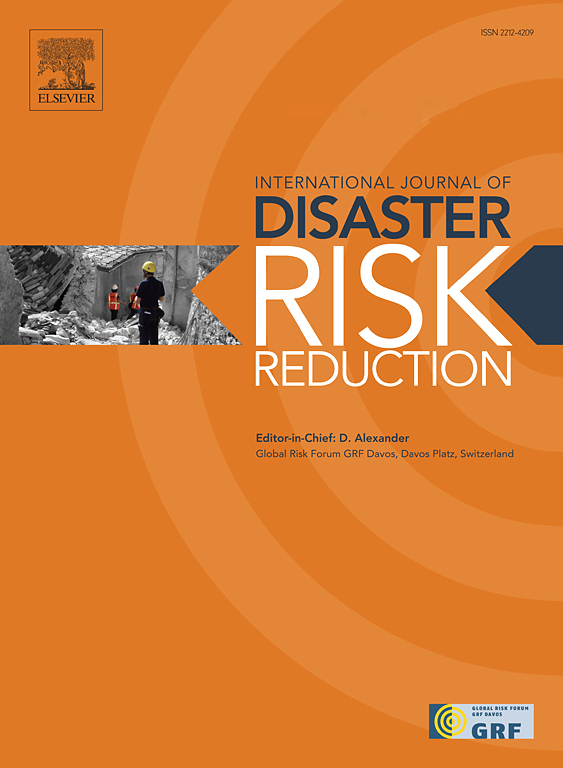IF 4.2
1区 地球科学
Q1 GEOSCIENCES, MULTIDISCIPLINARY
International journal of disaster risk reduction
Pub Date : 2025-03-01
DOI:10.1016/j.ijdrr.2025.105362
引用次数: 0
摘要
城市洪水是人口稠密城市面临的一个日益严峻的挑战,在全球范围内造成了巨大的人员和经济损失。虽然在洪水风险管理方面取得了进展,但在拉丁美洲和多米尼加共和国的城市中,邻里层面的脆弱性评估仍被忽视。为弥补这一不足,本研究结合地理空间分析和多标准决策方法,为圣多明各制定了洪水脆弱性指数(FVI)。通过文献综述和专家咨询确定了关键指标。采用层次分析法(AHP)为指标分配权重,综合考虑受灾程度、敏感性和适应能力。然后对这些指标进行汇总,以构建家庭脆弱性指数。结果显示,圣多明各社区之间存在差异,67%的社区为中度脆弱,19%为高度脆弱,13%为低度脆弱,6%为极度脆弱。适应能力是决定脆弱性的最重要因素,超过了暴露程度和敏感性,这强调了优先采取干预措施以提高城市复原力的必要性。已经提出了几种解决方案,以提高适应能力并减轻居民区的脆弱性。主要的政策建议包括加强预警系统、扩大城市绿地和改善防洪基础设施。本研究提供了一个基于地理信息系统的强大框架,用于识别脆弱地区并指导有针对性的适应战略。该框架有助于确定脆弱地区并指导有针对性的适应战略,为圣多明各及类似城市环境中的城市规划者、决策者和当地社区提供了宝贵的见解。本文章由计算机程序翻译,如有差异,请以英文原文为准。
Index-based mapping and assessment of flood vulnerability for climate adaptation at the neighborhood level: A case study of Santo Domingo, the Dominican Republic
Urban flooding is a growing challenge in densely populated cities, leading to significant human and economic losses worldwide. While progress has been made in flood risk management, assessments of neighborhood-level vulnerability remain neglected in cities across Latin America and the Dominican Republic. This study addressed this gap by developing a Flood Vulnerability Index (FVI) for Santo Domingo, integrating geospatial analysis and multi-criteria decision-making methods. Key indicators were identified through a literature review and expert consultations. The Analytical Hierarchy Process (AHP) was used to assign weights to the indicators integrating exposure, sensitivity, and adaptive capacity. These were then aggregated to construct the FVI. The results, mapped at the neighborhood level and classified into vulnerability categories revealed disparities among neighborhoods of Santo Domingo, with 67 % of the neighborhoods moderately vulnerable, 19 % highly vulnerable, 13 % low vulnerable, and 6 % very highly vulnerable. Adaptive capacity emerged as the most significant determinant of vulnerability, surpassing exposure and sensitivity, emphasizing the need to prioritize interventions that enhance urban resilience. Several solutions have been proposed to bolster the adaptation capacity and mitigate the vulnerability of neighborhoods. Key policy recommendations include enhancing early warning systems, expanding urban green spaces, and improving flood protection infrastructure. This study provides a robust, GIS-based framework for identifying vulnerable areas and guiding targeted adaptation strategies. The framework can facilitate identifying vulnerable areas and guiding targeted adaptation strategies, offering valuable insights for urban planners, policymakers, and local communities in Santo Domingo and similar urban contexts.
求助全文
通过发布文献求助,成功后即可免费获取论文全文。
去求助
来源期刊

International journal of disaster risk reduction
GEOSCIENCES, MULTIDISCIPLINARYMETEOROLOGY-METEOROLOGY & ATMOSPHERIC SCIENCES
CiteScore
8.70
自引率
18.00%
发文量
688
审稿时长
79 days
期刊介绍:
The International Journal of Disaster Risk Reduction (IJDRR) is the journal for researchers, policymakers and practitioners across diverse disciplines: earth sciences and their implications; environmental sciences; engineering; urban studies; geography; and the social sciences. IJDRR publishes fundamental and applied research, critical reviews, policy papers and case studies with a particular focus on multi-disciplinary research that aims to reduce the impact of natural, technological, social and intentional disasters. IJDRR stimulates exchange of ideas and knowledge transfer on disaster research, mitigation, adaptation, prevention and risk reduction at all geographical scales: local, national and international.
Key topics:-
-multifaceted disaster and cascading disasters
-the development of disaster risk reduction strategies and techniques
-discussion and development of effective warning and educational systems for risk management at all levels
-disasters associated with climate change
-vulnerability analysis and vulnerability trends
-emerging risks
-resilience against disasters.
The journal particularly encourages papers that approach risk from a multi-disciplinary perspective.
 求助内容:
求助内容: 应助结果提醒方式:
应助结果提醒方式:


